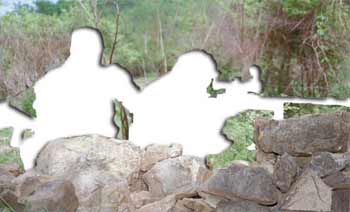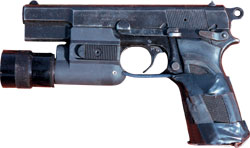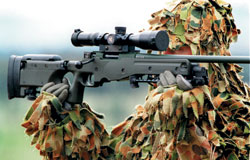Small arms of Australia's Special Forces
by Mike Wellington
Soldiers of Australia’s Special Air Service Regiment (SASR), operating with US Special Forces in the mountains of Southern Afghanistan against die-hard al Qa’eda and Taliban fighters, have been commended for their professionalism by both the American commander, Maj-General Frank Hagenbeck, and our own Chief of Special Operations, Brigadier Duncan Lewis.
 As Operation Anaconda unfolded in early March, a tragic accident took place in mountainous terrain when a US Special Forces soldier fell from the rear ramp of a helicopter, which had come under heavy enemy fire at a landing zone (LZ). A subsequent heliborne landing to rescue the troops, several of whom were by now dead or wounded, was also pinned down by enemy fire. An SASR reconnaissance team overlooking the embattled LZ promptly called down accurate air strikes from US aircraft, which dispersed the Taliban forces. Thirty-six American lives were saved.
As Operation Anaconda unfolded in early March, a tragic accident took place in mountainous terrain when a US Special Forces soldier fell from the rear ramp of a helicopter, which had come under heavy enemy fire at a landing zone (LZ). A subsequent heliborne landing to rescue the troops, several of whom were by now dead or wounded, was also pinned down by enemy fire. An SASR reconnaissance team overlooking the embattled LZ promptly called down accurate air strikes from US aircraft, which dispersed the Taliban forces. Thirty-six American lives were saved.
Having developed apace with the growing scourge of global terrorism, a sizeable proportion of the Australian Defence Force’s combat-ready element can be termed ‘special forces’. Troops of the Special Air Service Regiment (including an attached Royal Australian Signals squadron; a Royal Australian Navy clearance divers team [CDT 1]; the 4th [Commando] Battalion of the Royal Australian Regiment [4RAR Cdo] and the reservists of the 1st Commando Regt) comprise our Special Forces group. Trained to move fast and hit hard, they are capable of arriving in hostile territory by submarine insertion and powered rigid-inflatable boats such as the Zodiac F470 or by HALO (high altitude low opening) para drop.
The equipment used by these specialists is necessarily the very best that modern military technology can provide. Given the hazardous nature of their missions, often in jungle or mountainous terrain well beyond the normal range of assistance by conventional army units, their weapons and equipment must be the best available, both in reliability and suitability for the task at hand.
In limiting the scope of this article to ‘small arms’ as opposed to heavier vehicle-mounted or crew-served weapons, the logical starting point is the individual self-loading rifle.
While there is some leeway given for soldiers to use the weapon they feel most comfortable with, the rifles most commonly in use by our Special Forces group are the AuSteyr F88 IW (individual weapon) and the US-made Colt M4A1 carbine-rifle, both chambered for 5.56mm ammunition.
AuSteyr F88 IW
Following the introduction of the Steyr, with its unfamiliar ‘bull-pup’ construction and the equally unfamiliar ‘push-through’ safety device and in the wake of several accidents in which soldiers were killed or injured, a degree of early criticism was aimed at the weapon. However, most experienced soldiers consider the flak to be unwarranted and attributable to less-than-expert weapon handling.
During operations in Rwanda, Somalia, Cambodia, East Timor and now Afghanistan, the Steyr F88 has proved itself to be a reliable weapon in the hands of well-trained soldiers and will prove to be as highly regarded a workhorse as the heavier 7.62 mm SLR L1A2 it replaced.
Manufactured in Australia under licence by ADI Limited at its Lithgow, NSW plant, the F88’s integral but low-powered 1.5 magnification ’scope and correspondingly wider sight picture allows for rapid acquisition of the target. It is considerably more rapid than for example with the British 5.56mm equivalent, the SA80 with its higher-powered Sight Unit Small Arms Trilux (SUSAT) 4x magnification.
An air-cooled, gas-operated, magazine-fed weapon capable of automatic or semi-auto fire, the AuSteyr is issued in three variants. The general rifle version - the F88 - has a barrel length of 508mm and an integral optical sight.
The F88S has a barrel-length of 508mm but, with no built-in optical sight, facilitates instead by a picatinny rail and alternative sighting devices, such as the Night Weapon Sight (NWS), the British-made Hall & Watts ‘Wildcat’ 3.4 magnification sight and the standard F88 optic sight.
With a barrel length of only 407mm, the F88C (carbine) is almost 100mm shorter than the standard rifle and, unlike the other versions, does not include the attachment of the excellent combat knife-bayonet.
The versatility of this weapon is enhanced by the newly introduced 40mm Grenade Launcher Assembly (GLA), which will negate the requirement to carry either the M79 dedicated grenade launcher as an additional slung weapon or the M203 M16 rifle-grenade launcher combination.
 Colt M4A1 Carbine-Rifle
Colt M4A1 Carbine-Rifle
News footage of our special forces in Timor and Afghanistan will show many soldiers, faces normally shielded, carrying the M4 carbine rifle. The M4 is a lightweight, gas-operated, selective-fire weapon of 5.56mm NATO calibre with a collapsible stock. It is in effect a shortened and improved version of the Vietnam-era M16.
In its M4A version, the carrying handle that incorporates the rear-sight is dispensed with in favour of a picatinny-Weaver receiver rail on which can be mounted a range of optical sighting devices.
The official Defence Force answer for why special force commandos are also equipped with the M4 carbine in addition to the F88 is that the M4’s collapsible stock makes it a more useful weapon for use by paratroopers or commandos. Of greater significance perhaps is the increased capacity of the M4 to operate efficiently after immersion in water compared with the F88 - an important consideration for special force soldiers who often closed in with their objective as combat swimmers or by kayak.
 9mm Browning L9A1 Hi-Power
9mm Browning L9A1 Hi-Power
Depending on the nature of the mission, the special force soldier will occasionally use a pistol as his principal weapon. This applies particularly to the clandestine operation that may require the soldier in civilian clothes to blend with the general population. An example of this type of duty is the Close Quarters Protection of military and civilian VIPs, particularly in operational areas such as East Timor or Afghanistan.
Though the SASR inventory includes several types of handgun, including the Swiss-made SIG Sauer P-228, the special force mainstay remains the rugged 9mm Browning L9A1 Hi-Power self-loading pistol (SLP). A single-action, recoil-operated pistol, the L9A1 SLP can be readily adapted for use with a red-dot projector or tactical light.
As a youthful British military policeman in the early ’60s, my personal weapon was usually the 9mm Browning FN Hi-Power pistol 44 pattern with lanyard ring. The Browning pistol currently in use by our special forces has changed little since those days. And why should it? This pistol with its 13-round capacity mag (advisably loaded with no more than ten if the magazine is to remain charged for an extended period) has proved itself under all conditions.
Of interest, from an historical point of view, is that the Germans, with their proven excellence in weapon technology, were happy to appropriate 120,000 of these pistols for their own use on overrunning the FN (Fabrique Nationale) plant in Herstal, Belgium in 1940.
Sub-machine-guns
Without doubt one of the most enduring images of the special force trooper is the group of black-suited British SAS climbing the balconies of the Iranian Embassy in London in 1973, armed with their Heckler and Koch sub-machine-guns. Given the instantaneous live-or-die nature of these close-quarter engagements, the choice of the right sub-machine-gun (SMG) was vital.
The 9mm H&K MP5 and MP5SD are also our special forces’ sub-machine-guns of choice. Capable of firing full auto at 800 rounds per minute from a 30-round magazine to a range of 100 metres, the MP5 is a highly reliable close-quarters weapon. Taking its basic design characteristics from the successful 7.62mm H&K G3 rifle, the MP5 utilises the same delayed blowback operation, allowing accurate fire from a closed bolt. This weapon’s fire selector allows the soldier to fire single shots, three-round bursts or a continuous ‘spray and pray’ burst in the unlikely event it becomes necessary.
Immediately identifiable by the thickened cylindrical fore-section, which is the standard sound-suppressor, the H&K MP5SD can also be fitted with accessories such as the tactical light and laser designator.
The MP5’s three-round burst capability is vitally important when, for example, the ‘target’ is situated in close proximity to his or her hostages or has mingled with the passengers in an airliner’s cabin. Longer bursts of, say five or seven rounds, would inevitably result in reduced accuracy - with possibly fatal results for innocents surrounding the terrorist target.
The elimination of key enemy personnel such as high-ranking officers, political identities and technicians has long been an important role for both special force troops and conventional infantry sniper teams. Additionally, the effects of seeing officers, sentries and mates being routinely killed by accurate sniper fire from an unknown source can have a devastating effect on the morale of an enemy unit.
 Sniper Rifles
Sniper Rifles
Having relied for years on a succession of sniper rifles, including the venerable .303 No 4 Mk 1 (T) and later the 7.62mm Parker Hale 82, the Australian Army has now accepted for service the Accuracy International 7.62mm AW sniper rifle, designated the Aust SR98.
With its Schmidt and Bender variable telescopic sight (3 to 12x50), Harris bipod, butt-spike and fully-adjustable cheek comb and shoulder stock, the SR98 rifle is accurate to 1000 metres and is equipped with a picatinny rail, enabling attachment of the range of sighting devices currently in service. A School of Infantry sniper instructor described the SR98 as being “highly soldier-proof and easily serviced by soldiers and armourers”.
The ability to kill enemy personnel at long range is only half of the equation. Following exhaustive trials, the army has adopted the 12.7mm (.50 cal) Accuracy International AW50 Anti Materiel Rifle (AMR). Incorporating a large degree of commonality with the SR98, the AMR, with its blockbusting projectile and 12x power Schmidt and Bender ’scope, gives the gunner the capability to ‘kill’ hard targets such as radar and communication installations, vehicles, heavy weapons - and soldiers - at ranges of up to 1500 metres.
Other features of the AW50, which make this weapon a valuable addition to Australia’s armoury, include a muzzle brake and flash suppressor, integral Harris bipod, butt spike, adjustable shoulder stock and, significantly, a commonality of tools and spares with its little brother, the sniper’s 7.62 SR98. Field repairs are also relatively straightforward due to much of the weapon’s stripping being by means of an Allen key.
Although the anti-recoil system certainly bleeds off much of the AW50’s considerable kickback, to fire more than four or five rounds in close succession would be an unwelcome experience. Possibly the most discomfort is reserved for the gunner’s mate who, lying alongside with binos or spotting ’scope, cops much of the muzzle brake’s back blast and dust tornado.
However, the AW50 and the SR98 are by definition one-shot, one-hit weapons in the hands of an expert - and Australia’s snipers are considered to be world-class. Any requirement for a second shot is unlikely - and dangerous considering the possibility of detection by keen-eyed observers.
Reliability and excellence in performance could well be the watchwords employed by Australia’s defence chiefs when trialling and finally selecting the weapons with which to arm our special forces - qualities which the men themselves have in abundance.
Due to the secrecy of the identification of Special Force soldiers, photographs illustrating the nature of these groups are hard to come by.
